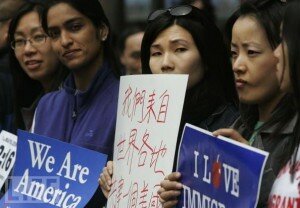Does “Asian America” leave some Asian Americans behind?
Talk About Race — By Keith Kamisugi on March 8, 2010 at 09:20I had lunch a few months ago with Bill Tamayo, the regional attorney in San Francisco for the U.S. Equal Employment Opportunity Commission.
We both have roots in Hawai‘i. Tamayo is a second-generation Filipino American. I’m a fourth-generation Japanese American. Many would consider us both “Asian American.” And each of us wondered whether that label really represents our “Asian” brothers and sisters – and if it’s the banner we should be following in advancing our communities.
In remarks delivered 10 years ago on the island of O‘ahu at a Joint Conference of the Asian Pacific American Law Teachers and the Western Law Professors of Color, Tamayo questioned whether all Americans of Asian descent share the same “Asian Pacific American” vision.
Filipinos, he said, and “other Asian predominantly immigrant communities don’t necessarily identify with the ‘Asian American’ experience against discrimination the way many of us assume they should.”
“Within the broader national [Asian Pacific Islander] community there is effectively a ‘pecking order’ not unfamiliar to Filipinos and those not otherwise Japanese and Chinese,” said Tamayo. “This stratification reflects in part our nation’s discriminatory immigration laws, colonialism and the need for labor at certain junctures.”
The hierarchy that Tamayo talked about 10 years ago remains today and continues to manifest profound disparity in our “pan-Asian” communities.
Let’s just look at Filipino Americans in California, one of the most populous Asian ethnic groups in the state, which is also home to approximately 60 percent of all Americans of Filipino heritage.
On the political front, no Filipino American has ever been elected to the California State Assembly, even though by my count, a little more than 20 Asian Americans have served in the California Legislature, including ten currently serving in the Assembly and one in the Senate.
Six of those current members are of Chinese ancestry. Three are of Japanese descent. Of the last two members, one is Korean American and the other is Vietnamese American – and both were the first from their respective communities to be elected to the Legislature.

NEW YORK - MAY 01: Vanessa Leung (C, behind white sign) with the Coalition for Asian-American Children and Families, stand with other activists during an sidewalk rally against proposed crackdowns on illegal immigrants May 1, 2006 in Chinatown in New York. Leung is an American citizen, but is the daughter of Asian immigrants. Immigrants and their supporters around the nation are rallying together through marches and demonstrations, along with boycotting work and spending, in a consolidated effort to show their importance throughout American society as the ongoing political debate on immigration reform continues. Photo: Chris Hondros/Getty Images
Americans of Chinese, Filipino, South Asian and Vietnamese descent comprise the four largest Asian American communities in California. (In addition to the absence of a Filipino American from the history of the California Legislature, voters have never elected a South Asian to that body as well.)
Four Fil-Ams to date have offered their candidacies for the Legislature: Larry Asera, Henry Manayan, Christopher Cabaldon and Arlie Ricasa. In looking back at the reasons for their respective defeats, I wonder if the lack of enough support from other Asian American communities was a factor. And whether the Asian American hierarchy that Tamayo mentioned had a role in these electoral outcomes.
Granted, success and defeat in politics often results from a more complex combination of factors than simply Asian American community dynamics. And no candidate should be supported or elected to office just because of her or his ethnicity.
Although numerous other Filipino American candidates throughout the country have faced similar obstacles, Hawai’i is (no surprise) the exception. Ben Menor became the first Fil-Am elected to a state legislature in 1962 and Ben Cayetano became the first Fil-Am elected a state’s governor in 1994.
Those are undeniably incredible achievements, but in the context of Hawai’i’s unique demographics and longer history of Filipino American empowerment – we cannot point to political success in Hawai’i to offset the lack of Fil-Am electoral success in the continental U.S.
This brings us back to the bigger picture of whether all communities of Asian descent have equally shared in the collective successes we attribute to “Asian Americans.”
My response is a conditional “no.”
If some of our communities are left behind as others move forward, we cannot claim victory for all Asian Americans, much less for “AAPIs” – the even more artificial acronym that tries to encompass Pacific Islanders, including Native Hawaiians.
Tamayo’s speech does not broadly dismiss the Asian American and AAPI labels, but he points out the serious challenges the category creates.
“Our historic responsibility,” he said, “requires that we not presume unity because unity can only be built through hard work … and that we need to acknowledge and understand the distinct experiences that shape hearts and minds, and then use them as building blocks for unity and action.”
“We simply cannot skip these steps.”
In the decade since, I’m not sure we followed Bill Tamayo’s wise counsel.
Tags: asian, california, community, filipino, legislature, pacific islander, Politics, south asian, Talking about RaceAuthor: Keith Kamisugi (2 Articles)

Keith Kamisugi, EJS’s director of communications, is responsible for the organization’s media relations, new media strategies, IT and telecom. He was previously a consultant to EJS. Keith brings to EJS more than 10 years of public relations experience, including positions as a regional spokesman for Verizon Communications, account manager for technology PR agency Niehaus Ryan Wong and serving a diverse portfolio of companies as an independent consultant. He also served for four years on the executive staffs of Hawai’i governors John Waihee and Benjamin Cayetano.



 Share This
Share This Tweet This
Tweet This Digg This
Digg This Save to delicious
Save to delicious Stumble it
Stumble it





 Direct talks: Five myths
Direct talks: Five myths Tolerence, acceptance and princesses
Tolerence, acceptance and princesses








1 Comment
I think there needs to be some statement of definitions and criteria before one can answer the question “Does “Asian America” leave some Asian Americans behind?”.
“Asian American” is a category label for diverse groups of peoples that seems to me to echo the inaccuracies of the term “Indian” when applied to early residents of North America. It is not a self-selected label and seems primarily to define a general type of “otherness” (primarily “other than white”).
For representative political purposes, one question is: are you attempting to represent a biological “racial” group of some kind, or a cultural group of some kind?
Part of the narrative of both ‘race’ and ‘ethnicity’ categories like “Asian American” and “Japanese” and “Chinese” etc. is that people in particular racial or ethnic categories are expected to be automatically more authentic representatives of a particular culture. (And “culture” is rarely singular, but is instead an overlapping, intersecting, shifting set of cultural processes.)
That biologically linked cultural authenticity was perhaps never true and is certainly far less true now. (Biologically/”racially” I am Viking/Tibetan/German/Cherokee, in other words “white” However, I have often found that I know more about Japanese culture than a “Japanese” person born and raised in Southern California for example, but far less than someone of any race born and raised in Tokyo.) Culture is a process quite different than race or ethnicity.
However, I have often found that I know more about Japanese culture than a “Japanese” person born and raised in Southern California for example, but far less than someone of any race born and raised in Tokyo.) Culture is a process quite different than race or ethnicity.
So, to me, one question to be answered (perhaps before your title question can be) is this: What is it that is desired to be “represented” politically, a biological/’racial’ group, or a cultural one? And, in either case, what are the acceptance criteria and measurable characteristics to determine if they are met?